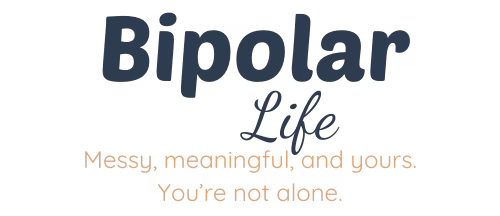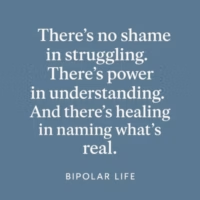🔧 The Difference Between a Mood Swing and a Bipolar Cycle
“Is It Just a Mood Swing?”
If you’ve ever wondered whether your mood shifts are “normal,” you’re not alone.
Maybe you’ve been called dramatic, too sensitive, or emotional. Maybe you’ve asked yourself, Am I overreacting—or is something actually wrong? The line between everyday emotional ups and downs and something deeper—like bipolar disorder—can be confusing, especially when you don’t have the language or support to name what you’re feeling.
This post is here to help untangle that line—not with judgment or labels, but with clarity, compassion, and information you can actually use.
This isn’t medical advice—it’s a way to help you better frame your experiences so you can talk more clearly and confidently with your medical provider.
🌦️ What Is a Mood Swing?
A mood swing is a sudden or noticeable shift in how you feel—maybe you wake up grumpy but cheer up after coffee, or you feel irritable for a few hours after a stressful meeting. These shifts are usually brief, often linked to something external, and don’t tend to derail your daily life. They’re part of being human.
Mood swings can be frustrating or uncomfortable, but they usually pass quickly. You might cry at a sad movie, snap at someone when you’re overtired, or feel euphoric after good news. These ups and downs are often tied to events, hormones, sleep, stress, or even diet—and while they can be intense, they tend to resolve on their own. That resolution might involve others—like apologizing or reconnecting—or it might be something internal, like adjusting your bedtime or setting better boundaries.
For people with bipolar disorder, mood swings can be misunderstood—by others and even by themselves. Not every mood change is a sign of an episode. But because of the diagnosis, ordinary emotional shifts may be met with anxiety, stigma, or overcorrection. Understanding the difference can help reduce fear and create space for self-compassion.
♾️ What Is a Bipolar Cycle?
A bipolar cycle refers to a period of time when a person experiences a shift into mania, hypomania, depression, or a mixed state. Unlike a typical mood swing, these cycles last longer—days, weeks, or even months—and often aren’t tied to a specific external cause.
These shifts don’t always make sense in the moment. You might feel suddenly elevated, restless, or euphoric with no clear reason—or drop into a heavy depression that lingers despite things going “well” in your life. The emotional intensity often comes with changes in sleep, energy, decision-making, motivation, or behavior that affect your ability to function.
Cycles are often unpredictable, but over time, many people begin to see patterns—like depressive episodes in winter or manic states after major stress. Tracking moods, events, and symptoms can help reveal those patterns and the triggers behind them—insight that becomes key in managing bipolar long term. Still, bipolar doesn’t follow a script. Some people cycle quickly, others slowly. What matters most is recognizing how your patterns show up.
🔍 Key Differences: Mood Swings vs. Bipolar Cycles
Understanding the difference between a mood swing and a bipolar cycle isn’t always simple—but there are some key markers that can help you recognize the difference.
| Mood Swings | Bipolar Cycles |
|---|---|
| Brief: minutes to hours | Extended: days, weeks, or longer |
| Triggered by events or stress | May happen without clear external trigger |
| Doesn’t usually disrupt daily life | Can impair work, relationships, or functioning |
| Emotional changes are more surface-level | Emotional shifts are deeper and often more intense |
| Resolved with rest, routine, or self-care | May require clinical support or medication |
| Common in all people | A feature of a mental health condition |
This isn’t a diagnostic tool, but it is a framework. If your emotional shifts consistently impact your functioning, relationships, or sense of safety, that’s a sign it’s worth discussing with a provider.
Life charts and mood tracking tools can help you see how extended or intense your shifts are—offering clarity about patterns you might not otherwise notice. They can also help you understand how your body responds to different medications. For instance, when I was given gabapentin for nerve pain after a root canal, I later learned it’s sometimes used as a mood stabilizer—and I noticed an unexpected leveling out. In contrast, the antidepressants I was prescribed in my late teens often pushed me into a manic episode. Tracking helped connect the dots that memory alone couldn’t.
🧠 Why It Matters
Understanding the difference between a mood swing and a bipolar cycle isn’t just about terminology—it’s about truth, trust, timing, and self-care. Caring for yourself enough to know that both mood swings and bipolar are okay is part of that. Knowing the difference—and acknowledging it to a professional—can save your life.
When bipolar symptoms are dismissed as “just mood swings,” people often go years without a diagnosis, misdiagnosed with depression or anxiety, or told they’re overreacting. This can delay treatment and increase the risk of crisis. It can also lead to a harmful treatment regimen—like medications that stabilize one symptom while inflaming another. On the flip side, someone who experiences intense emotions or situational highs and lows might fear they have bipolar disorder when what they’re really facing is burnout, trauma response, or another mental health challenge. Just the fear of a bipolar label can cause someone to avoid getting treatment altogether—even for simpler, manageable issues like insomnia or stress.
Having clarity can reduce the fear and self-blame. It opens doors—not only to treatment, but to a more compassionate understanding of yourself or your loved one. The right diagnosis isn’t a label—it’s a tool. One that can help you build a safer, more stable life.
📣 When to Seek Help
It’s not always easy to know when to reach out. But if your emotional highs and lows feel intense, unpredictable, or start to interfere with your daily life, it’s time to talk to someone.
Here are a few signs that what you’re experiencing might be more than a mood swing:
- Your mood changes last for several days or longer
- You notice shifts in your sleep, energy, or ability to focus
- Your behavior during highs or lows feels out of character
- You’ve experienced consequences—at work, in relationships, or financially
- You feel unsafe, overwhelmed, or unsure of what’s real
- You’ve been told by others that they’re concerned
You don’t need to wait until you’re in crisis. If something feels off—even if you can’t explain it—that’s enough reason to reach out. Start by keeping a mood journal or life chart. Jot down when your shifts begin and end, what else is going on in your life, and how it affects you. Bring those notes to your provider.
Sometimes, what looks like bipolar may turn out to be something else entirely—like anxiety, ADHD, trauma response, or another condition that affects your mood and energy. These conditions can overlap or mimic each other, and all of them deserve care and attention. A clear picture of your experience helps your provider make a more accurate diagnosis and tailor treatment to what you actually need.
You don’t have to know the answer before you ask for help. That’s what support is for.
🗺️ You Deserve Clarity
Your moods are not too much. Your emotions are not something to be ashamed of. Whether you’re riding out a rough patch or wondering if something deeper is going on, your experience matters—and it’s worth understanding.
Learning the difference between mood swings and bipolar cycles isn’t about putting yourself in a box. It’s about finding a language for what you’re going through so you can seek the support you need and deserve. This is one of those times when knowledge is power. It’s the power of freedom. For me, knowing that I could learn to control this—or that I had the medical help to manage it—gave me the freedom to be me. The real me, not the mask I wore to look “normal” or “okay.”
You don’t have to figure it out alone. Start where you are. Write it down. Track what you notice. Bring your notes and your questions. There’s help, there’s hope—and there’s a path forward.
✍️ Reflection Prompt
“When do I feel most like myself—and when do I feel least like myself? What clues might those moments offer about my mood patterns?”


